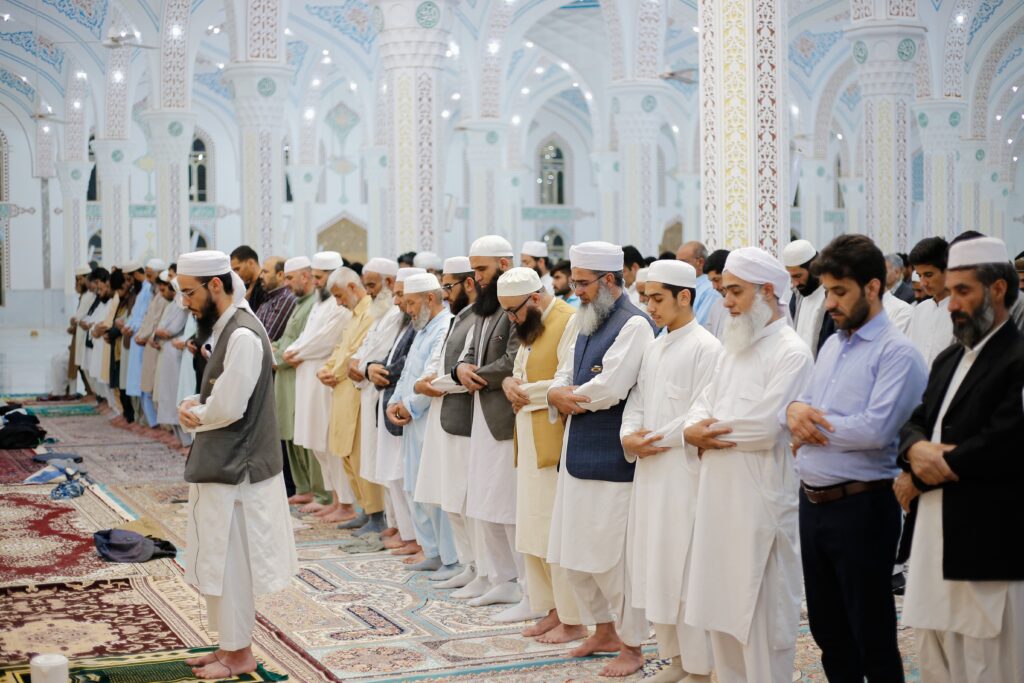라마단 기간 중 타라위(Tarawih) 기도의 중요성
Taraweeh 기도는 라마단 기간 동안 행해지는 Sunnah(자발적) 기도입니다. 이샤(Isha) 기도 후, 위트르(Witr) 기도 전에 바쳐집니다. 그 이름은 “휴식과 이완”을 의미하는 아랍어 단어 “tarawih”에서 파생되었습니다. 이는 각 라카 세트 사이에 휴식 시간을 두고 기도가 여유롭고 편안한 방식으로 수행되기 때문입니다.
다른 예배 행위(예: 디크르 만들기, 코란 읽기 등)와 마찬가지로 타라위 기도는 라마단 기간 동안 권장됩니다. 기도 안에서 우리는 알라(SWT)와의 연결을 강화하고 우리가 기도하는 각 라카트(라카, 라카)로 더 많은 보상을 얻습니다.
아부 후라이라(Abu Huraira)가 해설한 한 하디스에서 예언자 무함마드(ﷺ)는 이렇게 말했습니다.
“라마단의 자발적인 밤 기도에 믿음으로 그리고 보상을 바라는 사람은 누구나 이전의 죄가 용서될 것입니다.”
사히 부카리
그러므로 라마단 기간 동안 타라위(Taraweeh)를 포함하여 밤기도를 하면 상당한 보상이 있음을 알 수 있다.
모든 선행이 일년 중 다른 어느 때보다 더 많이 증가하는 때입니다.
타라위(Tarawih) 기도의 이점
Taraweeh 기도를 수행하는 것은 우리 자신과 신체의 모든 측면을 키우기 때문에 많은 이점이 있습니다.
알라(SWT)에게 더 가까이 다가가는 시간
길고 평화로운 기도 시간을 통해 우리는 알라(SWT)와의 관계에 대해 생각해 볼 수 있습니다. 각 행동을 통해 우리는 창조주께 더 가까워집니다. 우리는 그분에 대해 더 나은 인식을 갖게 되며 그분의 용서와 축복을 더 많이 구하게 됩니다.
향상된 집중력과 규율
Taraweeh 기도를 정기적으로 수행하려면 규율과 헌신이 필요합니다. 긴 기도 시간은 우리가 시간을 효과적으로 관리하도록 격려합니다. 이는 우리가 일상적인 책임을 수행하면서도 영적인 의무를 우선시하도록 촉구합니다. 또한 이는 우리가 더 큰 자기 훈련을 개발하는 데 도움이 되며, 이는 라마단 이후에도 우리 삶의 다른 측면에도 적용할 수 있습니다.
충격이 적은 운동
Taraweeh 기도는 우리의 영적, 정신적 건강을 돕는 것 외에도 신체 건강에도 도움이 됩니다. 어떤 면에서는, 오랫동안 기도하는 것이 우리가 더 많은 운동을 하도록 도와줍니다. 이 운동은 심장 건강을 개선하고 유연성을 높이며 스트레스 수준을 줄이는 데 도움이 되므로 충격이 적은 운동으로 작동합니다.
지역사회 유대 구축
우리가 Taraweeh를 기도하는 방식은 또한 우리의 단결과 공동체 의식을 강화시킵니다. 많은 모스크와 커뮤니티 센터에서는 각계각층의 무슬림들이 함께 모여 기도하고 예배하는 공동 Taraweeh 기도를 제공합니다. 이러한 공동체 의식은 라마단 기간 동안 특히 중요합니다. 이제 무슬림들이 단식하고, 음식을 나누고, 연결하고, 다른 예배 활동에 함께 참여할 때입니다.
Taraweeh 기도는 라마단의 주요 행사입니다.
타라위(Tarawih)를 기도하는 방법
Taraweeh를 기도하는 가장 일반적인 두 가지 방법은 20개의 라카 방법과 8개의 라카 방법이며, 4~2개의 라카마다 짧은 휴식 시간이 있습니다.
사용된 방법에 관계없이 각 라카트는 알 파티하 수라(Surah Al-Fatiha)를 낭송하는 것으로 시작하고 꾸란의 일부가 이어집니다. Witr 기도는 기도가 완료된 후에 수행됩니다.
또한 예언자 무함마드(ﷺ)의 수나(Sunnah)인 타라위(Taraweeh)를 회중에서 공연하는 것이 좋습니다. Abu Dharr(알라께서 그를 기뻐하시기를 바랍니다)의 설명에 따르면, 알라의 메신저(ﷺ)는 다음과 같이 말했습니다:
“누구든지 이맘이 끝날 때까지 옆에 서 있는 것은 밤새도록 기도하는 것과 같습니다.”
티르미디
전반적으로 Taraweeh 기도는 라마단의 중요한 관행입니다. 그것은 우리에게 알라와 연결되고, 그분의 용서를 구하며, 우리의 이마안(믿음)을 강화할 수 있는 기회를 제공합니다. 회중에서 자주 행해지는 타라위 기도를 하는 방법에는 여러 가지가 있지만, 가장 중요한 것은 성실함과 헌신으로 하는 것입니다.
Taraweeh 기도를 수행함으로써 우리는 알라(SWT)와의 영적 연결 강화를 포함하여 수많은 육체적, 영적 혜택을 얻을 수 있습니다. 이번 라마단 기간 동안 이 밤 기도를 수행하고 많은 혜택을 누리는 데 전념합시다. 알라(SWT)가 우리의 기도를 받아들이길 바랍니다.
THE SIGNIFICANCE OF TARAWEEH (TARAWIH) PRAYER DURING RAMADAN
Taraweeh prayer is a Sunnah (voluntary) prayer performed during the month of Ramadan. It is prayed after the Isha prayer and before the Witr prayer. Its name is derived from the Arabic word “tarawih,” which means “rest and relaxation.” This is because the prayer is performed in a leisurely and relaxed manner, with breaks between each set of rak’ahs.
Like with other acts of worship (e.g. making dhikr, reading Qur’an, etc), praying Taraweeh is encouraged during Ramadan. Within the prayer, we increase our connection with Allah (SWT) and earn more rewards with each Rakat (rak’a, rakah) we pray.
In one hadith, narrated by Abu Huraira, the Prophet Muhammad (ﷺ) even said,
“Whoever stands (in the voluntary night prayer of) Ramadan out of faith and in the hope of reward, his previous sins will be forgiven.”Sahih Bukhari
Therefore, we can see that there are significant rewards for praying night prayers, including Taraweeh during the month of Ramadan.
when every good deed is multiplied more than any other time of the year.
BENEFITS OF TARAWEEH (TARAWIH) PRAYER
Performing Taraweeh prayer has numerous benefits, as it nurtures all aspects of our self and body.
TIME TO DRAW CLOSER TO ALLAH (SWT)
The long and peaceful prayer session allows us to reflect on our relationship with Allah (SWT). Within each action, we grow closer to our Creator. We gain a better appreciation of Him and seek more of His forgiveness and blessings.
INCREASED FOCUS AND DISCIPLINE
Performing Taraweeh prayers regularly requires discipline and commitment. The lengthy prayer sessions encourage us to manage our time effectively. It urges us to prioritise our spiritual obligations while still fulfilling our daily responsibilities. It also helps us develop greater self-discipline, which we can also apply to other aspects of our lives, even beyond Ramadan.
LOW-IMPACT WORKOUT
Along with helping our spiritual and mental health, Taraweeh prayers also benefit our physical health. In a way, the prolonged prayer session helps us get more exercise. It works as a low-impact workout, as its actions help to improve our heart health, increase flexibility, and reduce stress levels.
BUILDING COMMUNITY BONDS
The way we pray Taraweeh also strengthens our sense of unity and community. Many mosques and community centres offer communal Taraweeh prayers, where Muslims from all walks of life come together to pray and worship. This sense of community is especially important during the month of Ramadan. It is time Muslims fast, share food, connect and engage in other acts of worship together.

HOW TO PRAY TARAWEEH (TARAWIH)
The two most common methods of praying Taraweeh are the 20 rak’ahs method and the 8 rak’ahs method, with a short break after every 4 or 2 Rakats.
Regardless of the method used, each Rakat begins with the recitation of Surah Al-Fatiha, followed by a portion of the Quran. The Witr prayer is then performed after the prayer is completed.
It is also highly encouraged to perform Taraweeh in congregation, as this is the Sunnah of the Prophet Muhammad (ﷺ). As narrated from Abu Dharr (may Allah be pleased with him), the Messenger of Allah (ﷺ) said:
“Whoever stands with the imaam until he finishes, it is equivalent to spending the whole night in prayer.”Tirmidhi
Overall, the Taraweeh prayer is a significant practice of Ramadan. It provides us a chance to connect with Allah, seek His forgiveness and strengthen our imaan (faith). While there are different methods of performing Taraweeh prayer, which is frequently done in congregation, the most important thing is to do it with sincerity and devotion.
By performing Taraweeh prayer, we can reap numerous physical and spiritual benefits, including a strengthened spiritual connection with Allah (SWT). This Ramadan, let us commit to performing this night prayer and reaping its many benefits. May Allah (SWT) accept our prayers, ameen!










